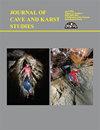新墨西哥州林肯县加利纳斯山脉含稀土岩浆热液角砾岩管道特征及成因
IF 0.5
4区 地球科学
Q4 GEOSCIENCES, MULTIDISCIPLINARY
引用次数: 0
摘要
角砾岩管是许多贵金属、贱金属和稀土矿床的共同宿主,为流体流动提供了管道,为矿物沉淀提供了开放空间,是勘探的重点领域。从1902年到1980年,新墨西哥州林肯县的加利纳斯山脉地区生产了铜、铅、银、荧光石、铁、稀土(如氟碳铈矿)和金,但没有从角砾岩管道中生产的报道。然而,加里纳斯山脉的一些岩浆热液角砾岩管中含有高浓度的萤石-稀土和金。前人的研究已经描述了角砾岩管中稀土元素的赋存状态,但其运移和沉积的控制因素尚不清楚。本研究的目的是对加利纳斯山岩浆热液角砾岩管道进行表征,以了解角砾岩管道中稀土和金沉积的地球化学和物理条件。在Pride断裂带西北方的断块上,有20多个暴露角砾岩管道侵入Yeso组、Glorieta砂岩、粗面岩和正长岩,形成一条东北走向的带,长约3-5公里。角砾岩管呈灰色至棕色,由花岗岩、花岗质片麻岩、砂岩、页岩、石灰岩、粗面岩和正长岩的角状或次圆形碎片组成,直径可达1米。大多数角砾岩管是由长石和石英基质支撑的,还有其他矿物和岩石碎片的小晶体。其中相当一部分角砾岩管经蚀变和风化,由次生赤铁矿和局部方解石、石英和萤石组成。一些岩石碎片在其边缘被硅化,其他碎片被萤石脉切割。在几个角砾岩管中发现了磁铁矿-赤铁矿的碎片。角砾岩呈轻稀土富集球粒陨石归一化模式。高氟样品也有高稀土元素和一些高金浓度。有些角砾岩稀土含量高达28,485 ppm,金含量高达121 ppb。初步研究表明,角砾岩管为岩浆岩,侵入寄主岩中,热液沿部分角砾岩管边缘沉淀出氟石ree和金。更多的研究正在进行中,以进一步验证这一假设。本文章由计算机程序翻译,如有差异,请以英文原文为准。
Characterization and Origin of the REE-bearing Magmatic-hydrothermal breccia pipes in the Gallinas Mountains, Lincoln County, New Mexico
Breccia pipes are a common host of many precious and base metal and rare earth elements (REE) mineral deposits because they provide conduits for fluid flow and open spaces for mineral precipitation, hence are a focus area for exploration.The Gallinas Mountains district in Lincoln County, New Mexico has produced copper, lead, silver, fluorite, iron, REE (as bastnaesite), and gold from 1902 to 1980, but no production has been reported from the breccia pipes. However, some magmatic-hydrothermal breccia pipes in the Gallinas Mountains host high concentrations of fluorite-REE and gold. Previous studies have described the occurrence of REE in breccia pipes, but the controls for their transportation and deposition are still unclear. The purpose of this research is to characterize the magmatic-hydrothermal breccia pipes in order to understand the geochemical and physical conditions of deposition of REE and gold in the breccia pipes found in the Gallinas Mountains. There are more than 20 exposed breccia pipes that intrude the Yeso Formation, Glorieta Sandstone, trachyte, and syenite, forming a northeast-trending belt, approximately 3–5 kilometers long in a fault block northwest of the Pride fault. The breccia pipes are gray to brown and consist of angular to subrounded fragments of granite, granitic gneiss, sandstone, shale, limestone, trachyte, and syenite that are as much as 1 m in diameter. The majority of the breccia pipes are matrix-supported with a groundmass of feldspar and quartz, along with small crystals of other minerals and rock fragments. Significant number of these breccia pipes are altered and weathered, consisting of secondary hematite and local calcite, quartz, and fluorite. Some rock fragments are silicified around their edges and other fragments are and cut by fluorite veins. Fragments of magnetite-hematite ore are found in several breccia pipes. the breccia exhibit light REE-enriched chondrite-normalized patterns. Samples with high fluorine also have high REE and some have high gold concentrations. Some breccia contain as much as 28,485 ppm total REE and 121 ppb Au. Preliminary studies suggest that the breccia pipes are magmatic and intruded into the host rocks and, subsequently, hydrothermal fluids precipitated fluorite-REE and gold along the edges of some breccia pipes. Additional studies are underway to further test this hypothesis.
求助全文
通过发布文献求助,成功后即可免费获取论文全文。
去求助
来源期刊

Journal of Cave and Karst Studies
地学-地球科学综合
CiteScore
1.90
自引率
0.00%
发文量
6
审稿时长
>12 weeks
期刊介绍:
The Journal of Cave and Karst Studies is a multidisciplinary journal devoted to cave and karst research. The Journal is seeking original, unpublished manuscripts concerning the scientific study of caves or other karst features. Authors do not need to be members of the National Speleological Society, but preference is given to manuscripts of importance to North American speleology.
 求助内容:
求助内容: 应助结果提醒方式:
应助结果提醒方式:


